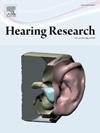Projections from the ventral nucleus of the trapezoid body to the dorsal cochlear nucleus in the rat: Morphology, distribution, and cellular origin
IF 2.5
2区 医学
Q1 AUDIOLOGY & SPEECH-LANGUAGE PATHOLOGY
引用次数: 0
Abstract
Animals integrate auditory and somatosensory stimuli because the perception of sounds depends not only on their position relative to the sound source, but also on the posture of the head and ears. In the mammalian brain, audiotactile integration already occurs in the dorsal cochlear nucleus (DCN), a very early station of the central auditory pathway. In the DCN, auditory inputs preferentially target the deep layer, whereas somatosensory inputs innervate granule cells, whose axons target the superficial, molecular layer. However, there is an often overlooked major pathway that presumably conveys direct auditory information to the molecular layer of the DCN: the projection from the contralateral ventral nucleus of the trapezoid body (VNTB), first characterized by Warr and Beck (1996, Hear. Res., 93:83–101).
To investigate in detail the morphology and distribution of the VNTB-to-DCN projection, we injected the bidirectional tracer biotinylated dextran amine (BDA) into the VNTB of adult rats and analyzed the axons that innervate the DCN. Moreover, to identify the neurons that innervate the DCN, we injected BDA into the DCN and analyzed the retrogradely labeled VNTB neurons.
Our results show that the VNTB-to-DCN projection is very predominantly contralateral. The axons reach the cochlear nuclei via the rostral part of the trapezoid body. Within the DCN, VNTB axons form a very dense plexus that covers the entire molecular layer and, to a lesser extent, the underlying fusiform cell layer. These axons bear a high number of en passant and terminal synaptic boutons. In the plexus, parasagittal bands of higher density perpendicular to the pial surface alternate with bands of lower density. The VNTB-to-DCN projection is tonotopic. The DCN is innervated by medium-sized multipolar neurons that occupy the ventral two-thirds of the VNTB and are distributed throughout the rostrocaudal extent of the nucleus. Moreover, the deep layer of the DCN is innervated by the ipsilateral lateral nucleus of the trapezoid body.
Although the biological role of the VNTB-to-DCN projection remains unknown, the available evidence from the literature suggests that it is GABAergic. Given its density, the projection may be very relevant to the functions of the DCN. Therefore, this projection should be considered in future investigations of DCN physiology and pathology, and should be incorporated into future morphofunctional schemes and models of the DCN.
大鼠梯形体腹侧核向耳蜗背侧核的投射:形态、分布和细胞起源
动物将听觉和体感刺激结合在一起,因为对声音的感知不仅取决于它们相对于声源的位置,还取决于头部和耳朵的姿势。在哺乳动物的大脑中,听觉整合已经发生在耳蜗背核(DCN),这是中枢听觉通路的一个非常早期的站点。在DCN中,听觉输入优先以深层为目标,而体感输入支配颗粒细胞,其轴突以表面分子层为目标。然而,有一个经常被忽视的可能将直接听觉信息传递到DCN分子层的主要途径:来自对侧梯形体腹侧核(VNTB)的投射,Warr和Beck (1996, Hear)首先描述了这一途径。Res, 93:83 - 101)。为了详细研究VNTB- DCN投影的形态和分布,我们将生物素化右旋糖酐胺(BDA)双向示踪剂注射到成年大鼠VNTB,并分析了支配DCN的轴突。此外,为了鉴定支配DCN的神经元,我们将BDA注射到DCN并分析逆行标记的VNTB神经元。我们的结果表明,vntb到dcn的投影主要是对侧的。轴突经梯形体吻侧到达耳蜗核。在DCN内,VNTB轴突形成一个非常密集的神经丛,覆盖整个分子层,并在较小程度上覆盖底层的梭状细胞层。这些轴突具有大量的过路和终末突触钮扣。在神经丛中,垂直于脑膜表面的高密度副矢状带与低密度带交替存在。vntb到dcn的投影是异位的。DCN由中等大小的多极神经元支配,这些神经元占据VNTB的腹侧三分之二,分布在整个核的背侧。此外,DCN的深层受梯形体的同侧外侧核的支配。尽管vntb - dcn投射的生物学作用尚不清楚,但文献中现有的证据表明它是gaba能的。鉴于其密度,投影可能与DCN的功能非常相关。因此,在未来的DCN生理学和病理学研究中应考虑这一预测,并应纳入未来的DCN形态功能方案和模型。
本文章由计算机程序翻译,如有差异,请以英文原文为准。
求助全文
约1分钟内获得全文
求助全文
来源期刊

Hearing Research
医学-耳鼻喉科学
CiteScore
5.30
自引率
14.30%
发文量
163
审稿时长
75 days
期刊介绍:
The aim of the journal is to provide a forum for papers concerned with basic peripheral and central auditory mechanisms. Emphasis is on experimental and clinical studies, but theoretical and methodological papers will also be considered. The journal publishes original research papers, review and mini- review articles, rapid communications, method/protocol and perspective articles.
Papers submitted should deal with auditory anatomy, physiology, psychophysics, imaging, modeling and behavioural studies in animals and humans, as well as hearing aids and cochlear implants. Papers dealing with the vestibular system are also considered for publication. Papers on comparative aspects of hearing and on effects of drugs and environmental contaminants on hearing function will also be considered. Clinical papers will be accepted when they contribute to the understanding of normal and pathological hearing functions.
 求助内容:
求助内容: 应助结果提醒方式:
应助结果提醒方式:


